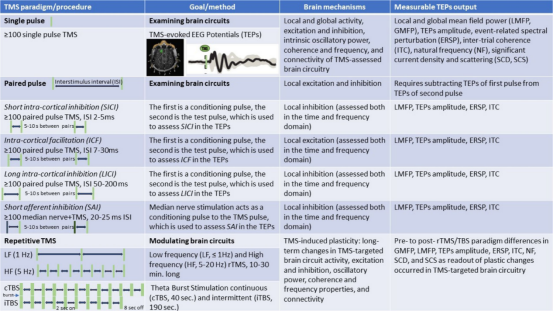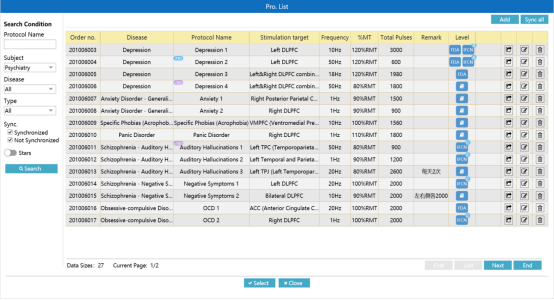Release time :2022-09-16
Source:support@yingchitech.com
Scan:1529
TMS is a non-invasive neuromodulation technology. The time-varying pulsed magnetic field can penetrate the skull non-invasively, act on the central nervous system, generate induced currents, and cause a series of physiological and biochemical reactions, thereby affecting metabolism and neuronal excitability in the brain so that improve and treat mental and neurological diseases.
In general, high-frequency stimulation increases the cortical excitability, whereas low-frequency stimulation has inhibitory control on the neural circuits. High-frequency rTMS (>5 Hz) produces an excitatory effect on neural tissue by inducing a form of long-term potentiation (LTP) that increases efficacy at the synapse that can last beyond the duration of a treatment session. Lowfrequency rTMS (≤1 Hz) produces an inhibitory effect on neural tissue via a long-term depression(LTD)-like mechanism.
Theta burst stimulation (TBS) is a form of TMS that also modulates neural function in a way that reflects LTP-like and LTD-like mechanisms that last longer than those induced by rTMS. TBS uses high-frequency bursts (3 pulses at 50 Hz) that are repeated at intervals of 200 milliseconds. Intermittent TBS (iTBS) increases the amplitude of neuron responses and increases cortical excitability in human motor cortex, whereas a continuous TBS (cTBS) pattern suppresses evoked responses.[]
TMS is a non-invasive brain stimulation technique uniquely equipped to both examine and modulate neural systems and related cognitive and behavioral functions in humans. As an examination tool, TMS can be used in combination with electroencephalography (TMS-EEG) to elucidate directly, objectively, and non-invasively the intrinsic properties of a specific cortical region, including excitation, inhibition, reactivity, and oscillatory activity, irrespective of the participant’s conscious effort. Furthermore, when applied in repetitive patterns, TMS has been shown to modulate brain networks in healthy individuals, as well as ameliorate symptoms in individuals with psychiatric disorders. The key role of TMS in assessing and modulating neural dysfunctions and associated clinical and cognitive deficits in psychiatric populations is therefore becoming increasingly evident.[]
TMS-evoked EEG Potentials (TEPs) consist of several peaks and troughs at specific
latencies which last several hundred milliseconds after the TMS pulse (Figure 1). In healthy individuals, TEPs can be utilized for several purposes, including: 1) measuring cortical inhibition and excitation; 2) assessing cortical oscillatory activity; and 3) examining cortico-cortical connectivity

Fig. 1 Transcranial Magnetic Stimulation (TMS) as a tool to examine and modulate human brain circuits. TMS paradigms (single pulse, paired pulse, repetitive TMS) and procedures (number of stimuli, interstimulus interval), goals (probing or modulating) and method (collecting TMSevoked EEG potentials, or TEPs), brain mechanisms (local and global activity, excitation, inhibition, oscillatory activity, and connectivity), and measurable TEPs output (GMFP, LMFP, TEPs amplitude, ERSP, ITC, NF, SCD, and SCS) are presented.
TMS has been utilized to establish dysfunctions of the excitatory and inhibitory properties, the oscillatory activity, and the connectivity of cortical areas in individuals with psychiatric disorders (Box 1). As a result of their ability to induce changes in the activity and connectivity of neural circuits that outlast the duration of stimulation, rTMS and, more recently, TBS, have been increasingly utilized in psychiatric populations as a potential treatment (11). Furthermore, since electroconvulsive therapy (ECT) is arguably the most effective intervention for several treatment-resistant psychiatric disorders, including schizophrenia and mood disorders, NIBS techniques such as rTMS and TBS have emerged as promising treatment options that require less intense stimulation than ECT while also providing more focal interventions and increased specificity of the neural targets being stimulated although perspective, properly randomized clinical trials comparing the efficacy of these interventions are needed in psychiatric patients (Box 1). Here, we focus on TMS findings in schizophrenia and mood disorder patients, the psychiatric disorders most studied using this technique.

Fig. 2 TMS: present practices in psychiatry
TMS can be employed to modulate the activity of neural circuits. This is usually achieved through repeated stimulation paradigms which include repetitive transcranial magnetic stimulation (rTMS) and theta-burst stimulation (TBS).
TMS has been applied to a growing number of psychiatric disorders as a noninvasive probe to study the underlying neurobiologic processes involved in psychiatric disorders and as a putative treatment. Transcranial magnetic stimulation is unparalleled in its ability to test the hypotheses generated by functional neuroimaging studies by modulating activity in selected neural circuits. As a focal intervention that may in some cases exert lasting effects, TMS offers the hope of targeting and ameliorating the circuitry underlying psychiatric disorders. The ultimate success of such an approach depends on our knowledge of the neural circuitry underlying these disorders, of how TMS exerts its effects, and of how to control the application of TMS to exert the desired effects. Although most clinical trials have focused on the treatment of major depression, increasing attention has been paid to schizophrenia and anxiety disorders. Many of these trials have supported a significant effect of TMS, but in some studies the effect is small and short lived. Current challenges in the field include determining how to enhance the efficacy of TMS in these disorders and how to identify patients for whom TMS may be efficacious.[]


Fig. 3 Common TMS treatment protocol for psychiatric diseases